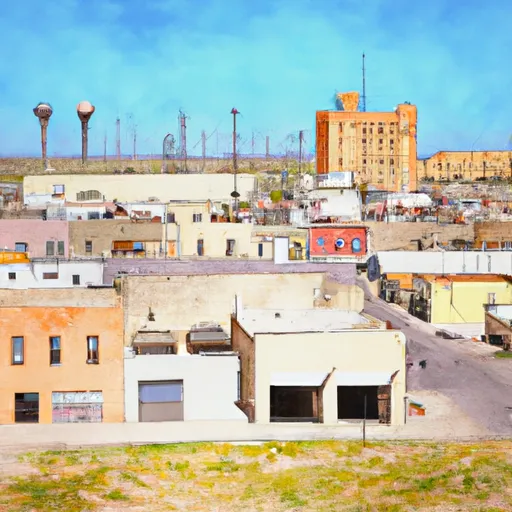-
 Snoflo Premium
Snoflo Premium
Get unlimited access to all our content
With no Ad interruptions! - Start Your Free Trial Login with existing account
San-Elizario
Eden Index
Climate
8.7
•
Recreation
2.2
•
Community
1.4
•
Safeguard
4.6/10

San Elizario is a historic town located in El Paso County, Texas. It experiences a semi-arid climate characterized by hot summers and mild winters. Summers are typically scorching with temperatures often exceeding 100°F (37.8°C), while winters are relatively mild, rarely dropping below freezing. The town receives limited rainfall, averaging only around 10 inches (25 cm) annually, making it a desert-like environment.
Hydrologically, San Elizario lies in the Rio Grande Valley, near the Rio Grande River. The river serves as a vital water source for the area, supplying irrigation for agriculture and supporting local wildlife. The region also features several smaller creeks and tributaries, contributing to the hydrology of the area.
Outdoor recreation opportunities in San Elizario are abundant. The area is known for its picturesque landscapes, offering opportunities for hiking, birdwatching, and nature photography. Nearby, the Rio Grande River provides opportunities for fishing, boating, and kayaking. The historic San Elizario Plaza, featuring Spanish colonial architecture, is a popular spot for leisurely walks and exploring local shops and cafes. The town also hosts various cultural events and festivals throughout the year, showcasing the unique heritage of the region.
What is the Eden Index?
The Snoflo Eden Index serves as a comprehensive rating system for regions, evaluating their desirability through a holistic assessment of climate health, outdoor recreation opportunities, and natural disaster risk, acknowledging the profound impact of these factors on livability and well-being.
Climate Health Indicator (CHI): 8.7
San-Elizario receives approximately
223mm of rain per year,
with humidity levels near 50%
and air temperatures averaging around
18°C.
San-Elizario has a plant hardyness factor of
8, meaning
plants and agriculture in this region tend to thrive here all year round.
By considering the ideal temperature range, reliable water supplies, clean air, and stable seasonal rain or snowpacks, the Climate Health Indicator (CHI) underscores the significance of a healthy climate as the foundation for quality living.
A healthy climate is paramount for ensuring a high quality of life and livability in a region, fostering both physical well-being and environmental harmony. This can be characterized by ideal temperatures, reliable access to water supplies, clean air, and consistent seasonal rain or snowpacks.
Weather Forecast
Streamflow Conditions
Rio Grande-Fort Quitman
Area Rivers
Rio Grande-Fort Quitman
Snowpack Depths
Rio Grande-Fort Quitman
Reservoir Storage Capacity
Rio Grande-Fort Quitman
Groundwater Levels
Recreational Opportunity Index (ROI): 2.2
The Recreational Opportunity Index (ROI) recognizes the value of outdoor recreational options, such as parks, hiking trails, camping sites, and fishing spots, while acknowledging that climate plays a pivotal role in ensuring the comfort and consistency of these experiences.
Access to outdoor recreational opportunities, encompassing activities such as parks, hiking, camping, and fishing, is crucial for overall well-being, and the climate plays a pivotal role in enabling and enhancing these experiences, ensuring that individuals can engage in nature-based activities comfortably and consistently.
Camping Areas
| Campground | Campsites | Reservations | Toilets | Showers | Elevation |
|---|---|---|---|---|---|
| Fort Bliss RV Military | None | 3,978 ft |
Catastrophe Safeguard Index (CSI):
The Catastrophe Safeguard Index (CSI) recognizes that natural disaster risk, encompassing floods, fires, hurricanes, and tornadoes, can drastically affect safety and the overall appeal of an area.
The level of natural disaster risk in a region significantly affects safety and the overall livability, with climate change amplifying these risks by potentially increasing the frequency and intensity of events like floods, fires, hurricanes, and tornadoes, thereby posing substantial challenges to community resilience and well-being.
Community Resilience Indicator (CRI): 1.4
The Community Resilience Indicator (CRI) recognizes that education, healthcare, and socioeconomics are crucial to the well-being of a region. The CRI acknowledges the profound impact of these elements on residents' overall quality of life. By evaluating educational resources, healthcare accessibility, and economic inclusivity, the index captures the essential aspects that contribute to a thriving community, fostering resident satisfaction, equity, and social cohesion.

